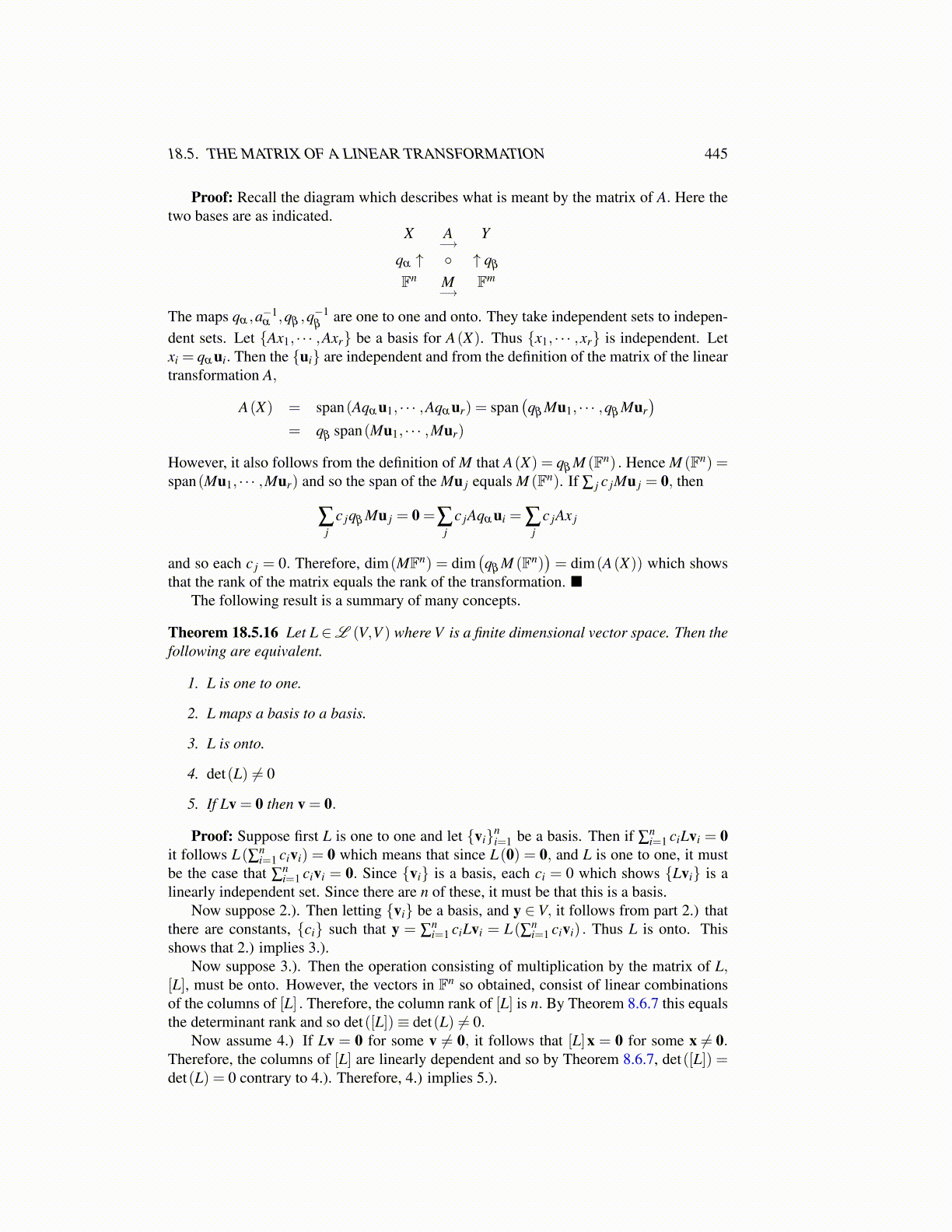
18.5. THE MATRIX OF A LINEAR TRANSFORMATION 445
Proof: Recall the diagram which describes what is meant by the matrix of A. Here thetwo bases are as indicated.
X A−→
Y
qα ↑ ◦ ↑ qβ
Fn M−→
Fm
The maps qα ,a−1α ,qβ ,q
−1β
are one to one and onto. They take independent sets to indepen-dent sets. Let {Ax1, · · · ,Axr} be a basis for A(X). Thus {x1, · · · ,xr} is independent. Letxi = qα ui. Then the {ui} are independent and from the definition of the matrix of the lineartransformation A,
A(X) = span(Aqα u1, · · · ,Aqα ur) = span(qβ Mu1, · · · ,qβ Mur
)= qβ span(Mu1, · · · ,Mur)
However, it also follows from the definition of M that A(X) = qβ M (Fn) . Hence M (Fn) =span(Mu1, · · · ,Mur) and so the span of the Mu j equals M (Fn). If ∑ j c jMu j = 0, then
∑j
c jqβ Mu j = 0 =∑j
c jAqα ui = ∑j
c jAx j
and so each c j = 0. Therefore, dim(MFn) = dim(qβ M (Fn)
)= dim(A(X)) which shows
that the rank of the matrix equals the rank of the transformation. ■The following result is a summary of many concepts.
Theorem 18.5.16 Let L ∈L (V,V ) where V is a finite dimensional vector space. Then thefollowing are equivalent.
1. L is one to one.
2. L maps a basis to a basis.
3. L is onto.
4. det(L) ̸= 0
5. If Lv = 0 then v = 0.
Proof: Suppose first L is one to one and let {vi}ni=1 be a basis. Then if ∑
ni=1 ciLvi = 0
it follows L(∑ni=1 civi) = 0 which means that since L(0) = 0, and L is one to one, it must
be the case that ∑ni=1 civi = 0. Since {vi} is a basis, each ci = 0 which shows {Lvi} is a
linearly independent set. Since there are n of these, it must be that this is a basis.Now suppose 2.). Then letting {vi} be a basis, and y ∈ V, it follows from part 2.) that
there are constants, {ci} such that y = ∑ni=1 ciLvi = L(∑n
i=1 civi) . Thus L is onto. Thisshows that 2.) implies 3.).
Now suppose 3.). Then the operation consisting of multiplication by the matrix of L,[L], must be onto. However, the vectors in Fn so obtained, consist of linear combinationsof the columns of [L] . Therefore, the column rank of [L] is n. By Theorem 8.6.7 this equalsthe determinant rank and so det([L])≡ det(L) ̸= 0.
Now assume 4.) If Lv = 0 for some v ̸= 0, it follows that [L]x = 0 for some x ̸= 0.Therefore, the columns of [L] are linearly dependent and so by Theorem 8.6.7, det([L]) =det(L) = 0 contrary to 4.). Therefore, 4.) implies 5.).